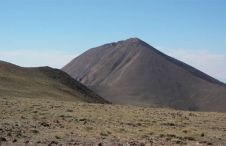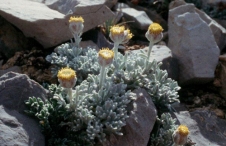Salt Desert Vegetation of Nevada
Nevada's numerous mountain ranges are separated by broad valleys that at first glance appear inhospitable to life. However, surprisingly diverse desert scrub communities have adapted to this harsh environment and are an important food source for localized herbivore populations.
At lower elevations, particularly in the Lahontan Basin in the western portion of Nevada, these valleys are dominated by shrub species with unique adaptations to salt, drought, and toxic minerals. For example, shadscale (Atriplex confertifolia), also known as saltbush, has specialized glands for the excretion of salt; iodine bush (Allenrolfea occidentalis) has succulent growth forms that store water for the dilution of salts. Other adaptations include leaf hairs, waxy cuticles, white dandruff-like scales that reduce loss of water, small leaves (whose limited surface area reduces evaporation), and deep taproots that reach groundwater.
While the environment may appear desolate and monotonous, over a dozen shrub species commonly occur, many of which are members of the Chenopodiaceae or Goosefoot family. As a result, ecologists sometimes refer to the desert scrub environment as the Shadscale Zone. However, there are clear gradients of species composition controlled by differences in salt and drought tolerance. Numerous species of flowering plants emerge after a wet winter or rare spring rain, ready to complete their life cycles by depositing seeds in anticipation of future wet years.
Greasewood species (Sarcobatus vermiculatus and S. baileyi), with deep roots capable of accessing groundwater as deep as thirty feet, dominate the saline clay soils of alkaline flats at playa margins. During the growing season greasewood is distinguished by bright green foliage—visible even while driving past on the highway—that belies the harshness of its environment.
Few plant species survive in the interior of the playa, but even there scattered clumps of iodine bush and the highly salt-tolerant saltgrass (Distichlis spicata) manage to survive. Particularly in areas of lower salt concentrations, winterfat or whitesage (Krascheninnikovia lanata) produces stands of silvery white herbage in the otherwise stark desert scrub landscape. The tender shoots of this short-statured shrub provide highly nutritious forage, so it seldom occurs in overgrazed areas.
In addition to disproving the notion that nothing grows in the desert, salt desert vegetation is an important year-round food source for mule deer, bighorn sheep, domestic livestock, and other herbivores, particularly in the winter when the mountains are covered in snow and little else is available.
Article Locations
Related Articles
Further Reading
None at this time.



